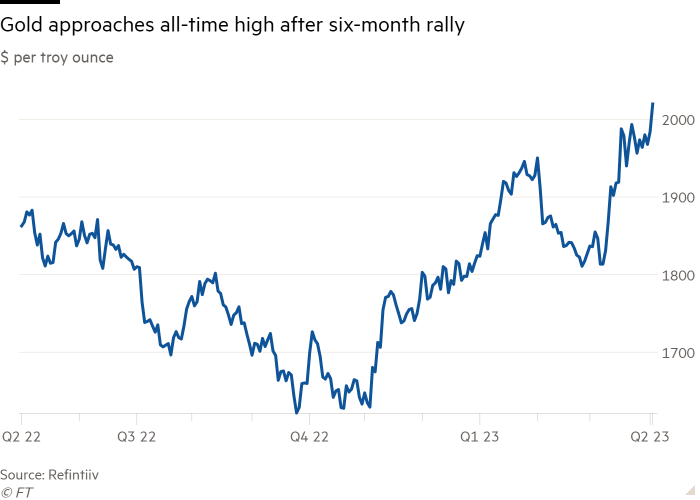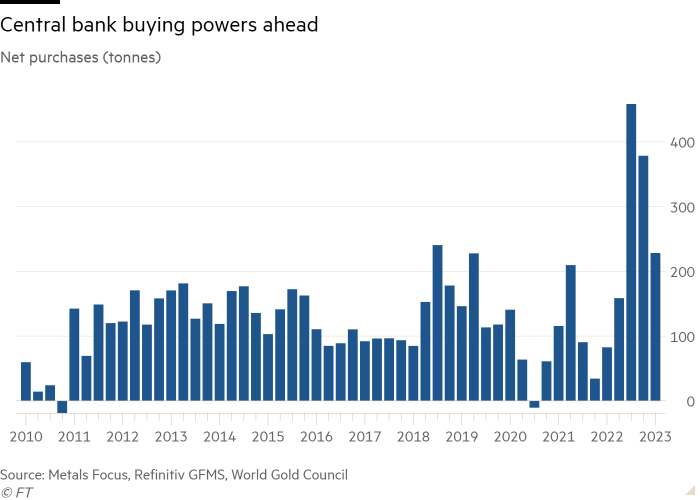US banking crisis pushes gold close to all-time high

Roula Khalaf, Editor of the FT, selects her favourite stories in this weekly newsletter.
Gold is closing in on an all-time high as resurgent Chinese demand and fears over the health of regional US banks have added further fuel to the six-month rally in the precious metal.
Consumers in China rushed to buy more jewellery, bars and coins in the first three months of the year after Beijing lifted its zero-Covid policies, according to the World Gold Council, an industry body, while the failure of three regional US banks has also prompted investors to turn to the yellow metal, which acts as a store of value in times of uncertainty.
The latest leg of a banking crisis, in which regional US bank PacWest said it was exploring a potential sale to secure its future, pushed trading in gold futures on the Comex exchange to match its all-time high of $2,072 on Thursday. The spot gold price came within cents of its all-time high of $2,072.49 on the same day, according to Refinitiv. It fell back slightly to $2,008 on Friday, after better than expected US jobs data raised the possibility that the Federal Reserve might have to lift interest rates further to tame inflation.
The recent rush towards an all-time high has been given further impetus by suggestions from the Fed that Wednesday’s rate rise could be its last. Expectations of interest rate increases dim the attraction of gold for investors as they miss out on the yield on bonds by holding bullion, which is non-yielding.

Gold has undergone a resurgence since November, underpinned by a record 1,087 tonnes of buying by central banks last year. Non-western institutions scooped up the yellow metal to counterbalance their reliance on the US dollar after Washington weaponised the greenback in its sanctions against Moscow.
The buying spree from central banks has extended into this year, picking up a record 228 tonnes of gold in the first quarter, despite easing off rampant levels seen in the second half of last year, according to the quarterly report by the World Gold Council.
John Reade, chief market strategist at the WGC, said that whether gold could push higher would depend on whether investors saw signs of a worsening banking crisis, certainty over when the US Federal Reserve would start cutting rates and a weaker dollar.
“There’s push and pull from different sides but what we’ve yet to see unleashed is widespread financial investment in gold,” he said. “It should from here certainly take it to the all-time high. The question is can it go on from here and make significant gains.”

However, gold-backed exchange traded funds suffered outflows last year because higher interest rates attracted investors to the returns on bonds compared with the precious metal, which is a non-yielding asset.
ETF outflows in the first quarter calmed to a modest 29 tonnes, equivalent to $1.5bn, and the 11-month run of outflows was reversed in March as the banking crisis kicked off.
As a result of those factors, demand for gold, including over-the-counter activity, rose 1 per cent over a year ago to 1,174 tonnes in the first quarter.
The high gold prices have caused some destruction in demand and prompted selling activity, particularly among price-sensitive consumers in India, where jewellery sales dropped 17 per cent year on year in the first three months of 2023.
Significant volumes of the record levels of central bank gold buying in the second half of last year were by mystery buyers that did not report purchases to the IMF. They were widely suspected to be Chinese, Russian and Middle Eastern entities.
That continued in the first quarter of the year with 110 to 120 tonnes of mystery purchases, which was lower than the 500 to 580 tonnes in the final six months of 2022.
Although the number can come down as central banks report their purchases, Reade said that the decline was most likely driven by the People’s Bank of China now reporting its purchases.
Comments